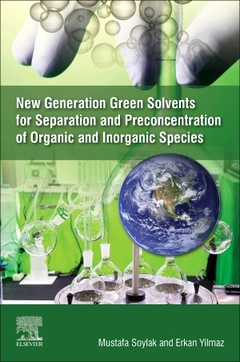New Generation Green Solvents for Separation and Preconcentration of Organic and Inorganic Species
Coordonnateurs : Soylak Mustafa, Yilmaz Erkan

New Generation Green Solvents for Separation and Preconcentration of Organic and Inorganic Species is designed to help researchers and students understand the production and application of new generation green solvents in separation- and preconcentration-based analytical methods. Beginning with the historical background and milestones in the development of analytical instrumentation, the book goes on to give a detailed overview of the most up-to-date uses of green solvents in sample preparation. Using a wealth of examples, it compares old and new extraction procedures and explores the many applications of new generation green solvents. Practical, easy-to-follow experiments are used to illustrate the key concepts.
This practical guide helps to promote the use of safer, more sustainable solvents in analytical chemistry and beyond for environmental scientists, researchers in pharmaceutical and biotech industries, and students in analytical chemistry.
2. Historical backgrounds, milestones in the field of development of analytical instrumentation
3. Type of new generation separation and preconcentration methods
4. New methodologies and equipment used in new generation separation and preconcentration methods
5. Type of green solvents used in separation and preconcentration methods
6. Ionic liquids in separation and preconcentration of organic and inorganic species
7. Supramolecular solvents in separation and preconcentration of organic and inorganic species
8. Switchable solvents in separation and preconcentration of organic and inorganic species
9. Deep eutectic solvents in separation and preconcentration of organic and inorganic species
10. Supercritical fluid extraction in separation and preconcentration of organic and inorganic species
Analytical chemists, environmental scientists, researchers in pharmaceutical and biotech and industries; researchers interested in improving analytical detection limits; graduate and post-graduate students in analytical chemistry and applied science (material science/engineering)
Dr. Yilmaz received his MSc. in Analytical Chemistry in 2012 and his PhD in Analytical Chemistry in 2016 from Erciyes University in Kayseri, Turkey. He carried out his MSc. and PhD studies on the synthesis and application of new generation green solvents and nanomaterials for preconcentration and extraction of trace organic, inorganic and biological analytes. Dr. Yilmaz has been working as research assistant and associate professor since 2009 in the Analytical Chemistry Department at Erciyes University. He has published more than 76 scientific articles in different journals in the areas of analytical chemistry, environmental chemistry, food chemistry, materials science and more. He received national best project awards for industrial application of green solvents and magnetic nanomaterials between 2016 and 2018. His current research is focused on the production and analytical application of new generation green solvents and nanomaterials.
- Covers the basic analytical theory essential for understanding extraction- and microextraction-based separation and preconcentration methods
- Explains combination use of new generation solvents with various detection systems, including UV-VIS, ICP-MS, HPLC, LC-MS, GC-MS, and LC-MS/MS
- Emphasizes trace chemical component separation, preconcentration and analysis
Date de parution : 04-2020
Ouvrage de 480 p.
19x23.3 cm
Thème de New Generation Green Solvents for Separation and... :
Mots-clés :
Absorbance; Absorption methods; Adsorption from the headspace; Adsorptive microextraction; Amperometry; Anion; Chromatographic; Chromatography; Cloud point extraction; Cooling; Copolymerization; Cyclodextrins; Density; Direct immersion solid phase microextraction; Dispersive liquid–liquid microextraction; Dispersive micro-SPE; Elecrogravimetry; Electrostatic; Fabricated; Glycerol; Gravimetry; Green analytical chemistry; Green solvents; Heating; Hexafluorophosphate; High-diffusion liquids; Hollow-fiber liquid phase microextraction; Homogeneous liquid phase microextraction; Hydrophobic interactions; Hyphenated techniques; Immunoaffinity solid phase extraction; In-tube solid phase microextraction; Inorganic; L-arginine; Liquid–liquid extraction; Magnetic solid phase extraction technique; Microextraction; Microextraction in a packed syringe; Microsolid phase extraction; Microwave energy; Milestones; Molecular chemistry; Molecularly imprinted solid phase extraction; Nanomaterials; New-generation separation and preconcentration methods; Organic; Parameter; Polychlorinated; Preconcentration; Quaternary ammonium salts; Rotating-disc sorbent extraction; Separation; Single-drop microextraction; Solid phase dynamic extraction; Solidified floating organic drop microextraction; Solvent; Solvents; Spectrometers; Stir-bar sorptive extraction; Stir-cake sorptive extraction; Stir-rod sorptive extraction; Supercritical; Supramolecular interaction; Switchable solvents; Temperature; Temperatures; Tetrahydrofuran; Ultrasound; Viscosity; Wavelengths



